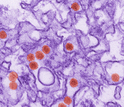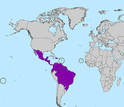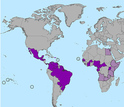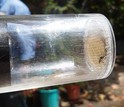News Release 16-014
National Science Foundation issues call for Zika virus proposals
Funding to address ecological transmission dynamics of the virus
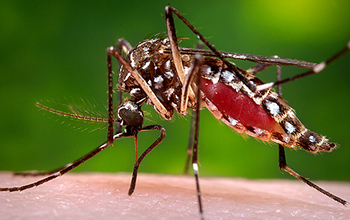
Aedes aegypti mosquito carried the Zika virus from Africa to South and Central America.
February 10, 2016
This material is available primarily for archival purposes. Telephone numbers or other contact information may be out of date; please see current contact information at media contacts.
Dengue, yellow fever, Japanese encephalitis, West Nile virus -- and now Zika. Is our interaction with the environment somehow responsible for the increase in incidence of these diseases?
Through a Dear Colleague Letter (DCL), the National Science Foundation (NSF) Division of Environmental Biology's Ecology and Evolution of Infectious Diseases (EEID) Program is accepting research proposals on Zika that address the ecological transmission dynamics of the virus.
"Zika is a serious and unique threat to public health," says James Olds, NSF assistant director for Biological Sciences. "It is also the latest example of an ongoing emergence of infectious diseases for which we need a better understanding of their ecology and evolution."
Zika outbreak spreading
Discovered in Uganda in 1947, Zika has been documented since the 1950s along an equatorial belt from Africa to Asia.
In 2014, the virus spread eastward to French Polynesia, and in 2015 to Mexico, Central America, the Caribbean, and South America, where the outbreak continues.
Zika is transmitted to humans through the bite of an infected Aedes aegypti mosquito. Because these mosquitoes are found throughout the world, it’s likely that outbreaks will spread to new countries, scientists say.
The illness Zika causes is similar to a mild form of dengue fever; it can't yet be prevented by drugs or vaccines.
The most common symptoms of Zika are fever, rash, joint pain, and conjunctivitis ("pink eye"). The illness usually lasts from several days to a week.
However, Zika virus can be spread from a pregnant woman to her unborn baby, and is suspected of causing birth defects. It may also be responsible for neurologic conditions in infected adults, including cases of Guillain-Barre syndrome, muscle weakness as a result of damage to the nervous system.
Predictive models and principles of transmission dynamics
NSF's EEID Program funds the development and testing of predictive models and discovery of the principles governing the transmission dynamics of infectious diseases such as Zika.
Zika project questions may include, but are not limited to:
- Which non-human species are hosts of Zika virus? In what frequency and spatial distribution does the virus occur?
- What is the rate at which Zika virus is transmitted between these vectors/carriers and humans?
- What is the rate at which Zika virus is spreading on a regional-to-continental scale, and can this spread be modeled and predicted?
- Can mathematical models of Zika virus transmission dynamics and spatial spread be developed to incorporate the effects of vector control methods?
How to submit an NSF EEID Zika proposal
NSF proposals may be submitted through one of two routes: as part of the annual call for EEID proposals or as a RAPID proposal (Grant Proposal Guide, Chapter II.D.1).
Before submission of a RAPID proposal, interested researchers should send a one-page summary of the project to zika@nsf.gov. The summary should include a statement of how the results of this research would be used to affect management of, or policies concerning, the spread of Zika virus within the next 12 months.
Projects with a more extended timeline should be submitted to the next EEID deadline.
Proposals that deal with disease etiology, pathophysiology, transmission from mother to fetus, transmission through sexual contact, development of diagnostics, or development of vaccines are not appropriate for submission to the NSF EEID program.
The National Institute of Allergy and Infectious Diseases has also published a notice of interest for research on Zika virus. Proposals on these topics, as well as the others addressed in that notice, should be directed to that agency.
-NSF-
-
Transmission electron micrograph (TEM) of the Zika virus.
Credit and Larger Version -
Map showing regions of the world where the Zika virus is currently active, as of Feb. 3, 2016.
Credit and Larger Version -
Zika: It arrived in Central and South America via Africa and Asia, then French Polynesia.
Credit and Larger Version -
Use of insect repellant is advisable in several regions, scientists say.
Credit and Larger Version -
Mosquito traps are common in locales such as Mexico City.
Credit and Larger Version
Media Contacts
Cheryl Dybas, NSF, (703) 292-7734, email: cdybas@nsf.gov
Related Websites
NSF Special Report: Ecology and Evolution of Infectious Diseases: http://www.nsf.gov/news/special_reports/ecoinf/
NSF News: To slow the spread of infectious diseases, NSF, NIH, USDA support new research: https://www.nsf.gov/news/news_summ.jsp?cntn_id=136044
NSF EEID Discovery Article Series: http://www.nsf.gov/discoveries/disc_summ.jsp?cntn_id=137557
The U.S. National Science Foundation propels the nation forward by advancing fundamental research in all fields of science and engineering. NSF supports research and people by providing facilities, instruments and funding to support their ingenuity and sustain the U.S. as a global leader in research and innovation. With a fiscal year 2023 budget of $9.5 billion, NSF funds reach all 50 states through grants to nearly 2,000 colleges, universities and institutions. Each year, NSF receives more than 40,000 competitive proposals and makes about 11,000 new awards. Those awards include support for cooperative research with industry, Arctic and Antarctic research and operations, and U.S. participation in international scientific efforts.
Connect with us online
NSF website: nsf.gov
NSF News: nsf.gov/news
For News Media: nsf.gov/news/newsroom
Statistics: nsf.gov/statistics/
Awards database: nsf.gov/awardsearch/
Follow us on social
Twitter: twitter.com/NSF
Facebook: facebook.com/US.NSF
Instagram: instagram.com/nsfgov



